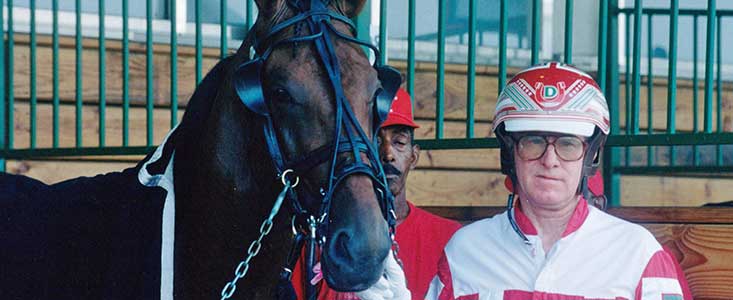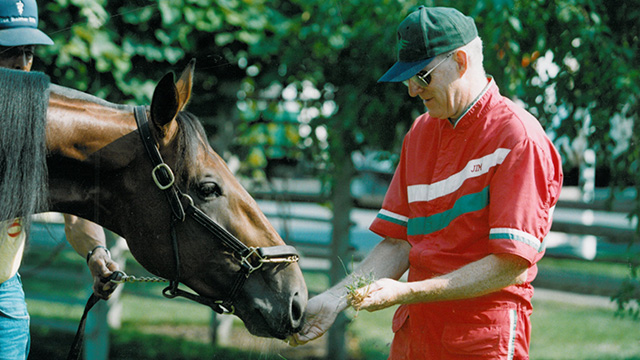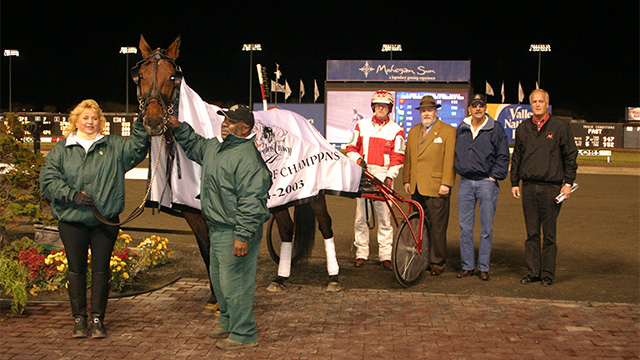Gentleman Jim's Wager: Doherty's Career Move

Saint John, New Brunswick-born Jim Doherty quietly defined excellence over a training and driving career spanning six decades.
His earliest victories, in the Maritimes, were instrumental in establishing his Hall of Fame career, but it was the gamble that he took, when relocating to the U.S. that pushed him over the top. By Melissa Keith

When you can’t ask the teacher, ask the student.
Saint John, New Brunswick-born Jim Doherty quietly defined excellence over a training and driving career spanning six decades. His earliest victories, in the Maritimes, predate the modern era of ready statistical and replay access, but his latter ones do not. Doherty’s great success with 1997 Dan Patch Three-Year-Old Trotting Filly of the Year, No Nonsense Woman (3,1:54; $1,261,909) came despite that Sierra Kosmos daughter’s hot-headed ways. After her first pari-mutuel start at age two, she was never truly beaten by another filly all that season; three losses came courtesy of her own breaks. Her seven seasonal victories can be attributed as much to Doherty’s patience and skill as to her own characteristic ability to leave at blistering speed and defend the lead. At three, with Doherty again in the sulky for every start, she blazed the Grand Circuit to 14 wins in 17 starts, including the Filly World Trotting Derby, the divisional Breeders Crown elimination and final, and her Matron Stake elimination and final.
Bill O’Donnell agrees with Rick Beinhauer, who owned and raced Sierra Kosmos: Without the gifted Doherty in her corner, No Nonsense Woman would have been too rank and unmanageable to race at the level she did, or maybe at all. “[Doherty] was quite a guy. He was a structured person. He could always get along with bad horses, even when he was young,” says O’Donnell, the Springhill, Nova Scotia horseman, and Hall of Famer in his own right.
O’Donnell admits that he did not know “Gentleman Jim” during the years when the 2018 Canadian Horse Racing Hall of Fame inductee raced at New Brunswick’s Exhibition Park Raceway. “But [Doherty] worked for my uncle, Art Porter, when he [Porter] was training for Milton Downey at Saint John,” he recalls. When Porter opted to return home to Springhill at the end of the racing season, Downey required a new trainer for his large stable, based at the Port City track. Porter recommended that Downey promote the 16-year-old Jim Doherty to head trainer.
“The best young horse he had when he was working for Downey was Time To Go,” remembers O’Donnell. “Later on, he bought a yearling for Milton and his name was Comte Richelieu. He raced with Andys Son all the time; he couldn’t beat him, but he raced with a him a lot. He [the horse] was older when I worked there.” Comte Richelieu was a former Exhibition Park Raceway track record holder, and a personal favourite who remained with Downey and Doherty even as an aged claiming horse.
Sackville Downs opened in 1955, and Art Porter went to work at the new track. “In ’65, when I was 17, that’s when I really met him [Doherty],” continues O’Donnell. “He sent his horse [Royal Salute] down to Art’s barn, and came down and drove him. He brought him down to race at Sackville.” The Free-for-Aller, owned by Milton Downey, was there for the Maritime Pacing Championship. The late 1960s were years in which Doherty faced the decision that all top Maritime horsemen must eventually make: whether to venture outside the region on a permanent basis. O’Donnell witnessed Doherty’s gamble, a wager made between dominance in the familiar Maritimes and going all-in at the competitive New England tracks:
“If there was a turning point in Jimmy’s life it was this: He was stationed, basically, in Saint John, New Brunswick, so he had better horses. Milton had some decent horses, so he’d go to Gorham or Lewiston, Maine in the fall to race them, when the horses were still fresh. Then he would come home for the winter. He went up to Montreal a few times, back in ’65 and ’66, with a couple. He made the big jump and went to Foxboro [Raceway] in ’69, for the summer, then he went to Rockingham [Park] that fall. Then he decided, ‘This is the place I’m going to stay,’ so he stayed instead of going home. That was really the turning point, staying there. And then I went to work for him in the spring of 1970.”
Doherty ensured his American arrival was properly documented. “He was driving a lot then, in the States on some sort of temporary visa. Then he got a green card and became permanent, so he could train for Americans,” explains O’Donnell. “Jim never did anything that wasn’t above board; he wouldn’t take a horse if he was afraid of causing a ruckus or anything like that. It just wasn’t him.”
Originally tasked with campaigning Downey’s horses in the United States, Doherty hired the then-unknown O’Donnell to look after three of them (Flying Knight, Best Of Scotch, and Uncles Mon) racing at Rockingham Park, in Salem, New Hampshire. “Later that year, 1970, he opened a public stable, so he took more horses on. He had Milton’s and then it just got bigger: 12 horses, then 15, then 20, 30, 40,” says O’Donnell.
In spite of his rapid rise to American success, was Doherty ever homesick? “No, but he still went home every chance he got,” remembers O’Donnell. “They had a race there in Saint John, the Alexander Memorial, and he always sent a horse home every year for that. If he didn’t have a horse to send home, then someone would send a horse there for him and he would go up there and drive it.”

A very hands-on trainer, the New Brunswicker was known for his full schedule, and his willingness to share his good fortune with others needing a little help. “He had a stable at Foxboro and a stable at The Meadowlands, and he would go to Foxboro every Sunday and race there. It’s not like he had a day off,” remembers the man who would eventually become Doherty’s most accomplished student. “I would have stayed there forever. I would have worked for him to the end. He gave me my first drive ever, with Gaza Lobell. I didn’t even really want to be a driver - he forced me into that. And when it was time for me to go out on my own as a trainer, he pushed me in that direction too. He had set it up that I was to get six or eight horses to train. I found out and asked him if he was firing me, and he just said that it was time for me to go out on my own. He said that if it didn’t work out that I could always come back. And off I went.”
O’Donnell also notes that something else ‘Gentleman Jim’ did often, was that he made a point of helping out up-and-coming trainers from Atlantic Canada, like Nova Scotia native Bill Cass, by catch-driving their horses for them whenever he could. He truly believed in helping people.
While his Canadian Hall of Fame induction comes 15 years after his induction into the Harness Racing Hall of Fame at Goshen, New York, it’s understandable: Doherty’s rise to the top of the sport corresponded with the debut of The Meadowlands, in 1976. He was able to attend his induction ceremony at Goshen, and drove there with his close friend of three decades, Maine trainer/driver and on-track rival Ted Wing. Having passed away on March 14, 2015, at the age of 74, Mr. Doherty goes into the Canadian Hall posthumously, but will be represented at the ceremony by his widow Marianne, his protege O’Donnell, and other members of the Doherty family.
Doherty’s stateside career overshadowed his accomplishments in the Maritimes, and his stable gradually took on more American-owned horses. “He and Milton were together from the time he was 16, until Milton just didn’t send any more horses to The Meadowlands because he didn’t have horses for there,” explains O’Donnell.
High-profile U.S. owners willingly filled that vacancy: William and Ann Rosenberg, of Dunkin Donuts fame, were among those who sent horses to the man nicknamed “Duffy”. Their best-known was 1984 and 1985 Dan Patch Aged Pacing Mare of the Year Green With Envy, who was trained and driven by the quiet, loyal Doherty. “The Rosenbergs, they had lots of trainers, until they met Jim Doherty,” confirms O’Donnell. The couple kept their racing stock with him from 1971 “until they got out of the business” around 2000. (William Rosenberg died in 2002).
The transplanted New Brunswicker was also something of a pioneer in bringing Down Under imports to American racetracks, notes O’Donnell. Many of those horses arrived with unwelcome habits, and Doherty was just the type of horseman to settle them down. Leroy N was one such project, he recalls: “He was a highly-touted horse from New Zealand, and he went to New York and fell down a couple of times in races and stuff. He was bad-mannered behind the gate, so they gave him to Jimmy.” Doherty’s approach to unruly Standardbreds was always to “outwait them”, rather than engage in a battle of wills, according to his best-known human protégé.

Behind the cool demeanour on the track and warm friendships off, Doherty privately battled a painful health condition. “He had a very bad stomach,” explains O’Donnell. “He went through so many bad bouts with colitis over his lifetime. He never complained, ever. I’ve seen him so bad that all he could eat was mashed potatoes and carrots.” Doherty would still show up at the stable every morning, break for tea at 10 o’clock, and drive multiple races a night. O’Donnell attributes Doherty’s success with high-strung performers like 2002 Maple Leaf Trot and Breeders Crown Open Trot winner Fools Goal (1:51.3; $3,462,761) to his being a “creature of habit.” Throughout his New Jersey-based years, Jim and Marianne lived in the same apartment, located a convenient three miles from The Meadowlands. Horses responded to the gentle horseman’s consistent approach, rewarding him with effort no amount of roughness can ever evoke.
O’Donnell says he expects a well-attended Canadian Horse Racing Hall of Fame induction ceremony for Doherty. “Believe me, he would have really, really appreciated this. He was Canadian, through and through: He hired Canadians, and I’m a perfect example. As a kid, he hired me to go down there and he pushed me to drive; even when I went on my own, he’d always make sure I had a horse or two to train. He always made sure you were looked after - he was just that type of guy.” Just a gentleman who won big, on the wager of a lifetime.


